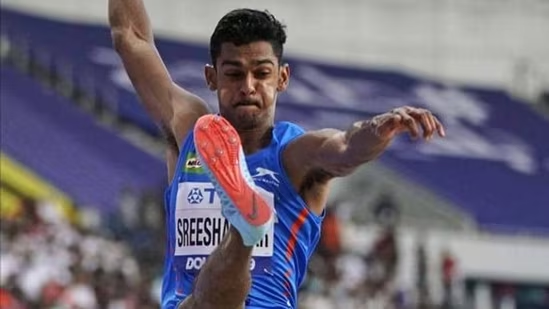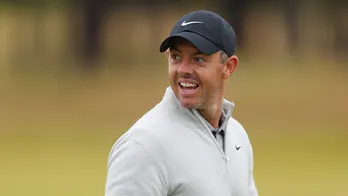Long jumper Murali Sreeshankar starts from scratch after dismal show in Tokyo
Long jumper Murali Sreeshankar is raring to take off in the new season. Confident that he is nearing full fitness, Sreeshankar says he wants to prove himself in a year packed with major events.  PREMIUM
PREMIUM
The 22-year-old, who is training at his home in Palakkad under his father and coach S Murali, is desperate to put behind his forgettable stint at the Tokyo Olympics.
He says a bout of COVID (though he never got tested) in April and badly-timed vaccination triggered a spate of health issues and made his body so weak that even taking off for a jump became an ordeal.
Sreeshankar just about managed to compete at the Olympics -- nowhere near his phenomenal qualifying jump of 8.26m in March -- and returned home with a devastated mind and wrecked body.
“After landing in India, I straightway visited my doctor. A series of consultations, tests, and recovery followed,” Sreeshankar elaborated on his travails.
“After almost six months, I can now say that the body is reacting well and I am making steady progress in training. I am doing weight training and technical jump sessions. I feel the signs are good. But I don’t want to rush because this season is going to be a bit long, it will continue till the end of September when we have the Asian Games. So, I have to be completely fit and things have to be planned carefully.”
Sreeshankar is looking to start his season with the World Indoor Championships in Belgrade from March 18. He wants to test his preparations in the meet and gradually peak towards big events -- World University Games (June 30-July 5), World Championships in Oregon (July 15-24), Commonwealth Games (July 28-Aug 8), and Asian Games (Sept 10-25). He will be looking to start his season at home in February before heading to a few European meets.
“The National Jumps Championships is expected to happen towards the end of February and hopefully I will start my season there. I will then be going for the Indoor World Championships. The indoor meet will be just a preparatory competition for me. If I could make it in the top-eight, it would be a good start to the season for me and my rankings will improve.
“It will help me to qualify at the World Championships in July which will be the main event besides three other high-priority competitions. I am really looking forward to maintaining consistency this season.”
Lack of consistency affected Sreeshankar last year. Following his national record jump of 8.26m at the Federation Cup in Patiala on March 16, his performance dipped inexplicably. In June, he jumped 7.74m at the Indian GP and was asked to appear for the Olympics selection trial in Bengaluru, where he was way off his best at 7.48m.
The Athletics Federation of India (AFI) cleared him with an assurance from his father and coach S Murali that he would give a good performance in Tokyo. However, bad run continued to afflict Sreeshankar. He could not progress to the final in the Olympics and finished 24th overall with a dismal 7.69m.
Sreeshankar describes his Olympics performance a ‘mishap’. He blames it on COVID and immediate vaccination that weakened his body.
“In the last week of April, I lost my smell and taste but there were no other symptoms. We continued to train. In May, I went for vaccination, because Tokyo Olympics-bound athletes were asked to take two doses. I took both shots within a month. If you are infected, then vaccination should be a bit delayed. Doctors and experts who I consulted later told me that all these factors combined to weaken my body. I also picked up injuries during the time.”
Sreeshankar quickly realised he was experiencing long spells of fatigue. He increased recovery time between sessions, but even that did not help. It reached a point where he was feeling so weak that he couldn’t take the pressure of training.
“Beginning the second week of May, after I had my first shot, I started feeling that things were going wrong. I was lethargic. I was not able to push at all. My father kept asking me what the problem was; he even increased my recovery time. One or two sessions would be good but when I would go for weight training or on track the next day, the progress would come down.
“The weights I used to lift easily, I was finding it difficult to make even one or two repetitions using them. I had to discontinue a lot of training sessions. My body was feeling tired. I was having problems getting sleep at night, it affected me a lot. And all of it happened so suddenly.”
Sreeshankar was happy to be cleared for Tokyo but was left dejected on the day of his event. “My body was in bad condition at the most important time of my career. I was in such good shape after recording 8.26m in India. I really felt I could have finished inside top six in Tokyo.”
The battle to regain fitness began after his return from Tokyo. Sreeshankar went to Inspire Institute of Sport in September and stayed there for a month for rehabilitation. He had to start from scratch.
“It was in a terrible shape. All jump parameters, strength, speed fitness levels, everything was bad. Then I had injury issues. My hip and glute muscles were very weak which affected my hamstring tendon as well as the medial part of my foot, and running and jumping were affected because of that. It was nothing but COVID.”
The recovery was gradual. “In four weeks, my fitness levels returned to 60 percent. I have now recovered to 90 percent.”
Sreeshankar has requested an exemption from the national camp for now. “I need some more time to get back to full fitness. We have asked permission (from AFI) for exemption till April or May. I prefer to train here with my father now.”
Sreeshankar’s poor show led AFI to question his father’s training programme. “I understand they had expectations from me and I could not rise up to it. I would like to take all these criticisms in a positive way and rectify all that this season,” he says.
“Many athletes had a mishap last year. Even Johannes Vetter never expected he would not enter top-8 in the javelin throw final in Tokyo. It’s important to leave all that behind. Hopefully, by March or April, I will be in full swing and I will be able to get some really solid jumps.”
Experience unrestricted digital access with HT Premium
Explore amazing offers on HT + Economist Start 14 Days Free Trial Already Subscribed? Sign In
Disclaimer: The copyright of this article belongs to the original author. Reposting this article is solely for the purpose of information dissemination and does not constitute any investment advice. If there is any infringement, please contact us immediately. We will make corrections or deletions as necessary. Thank you.







